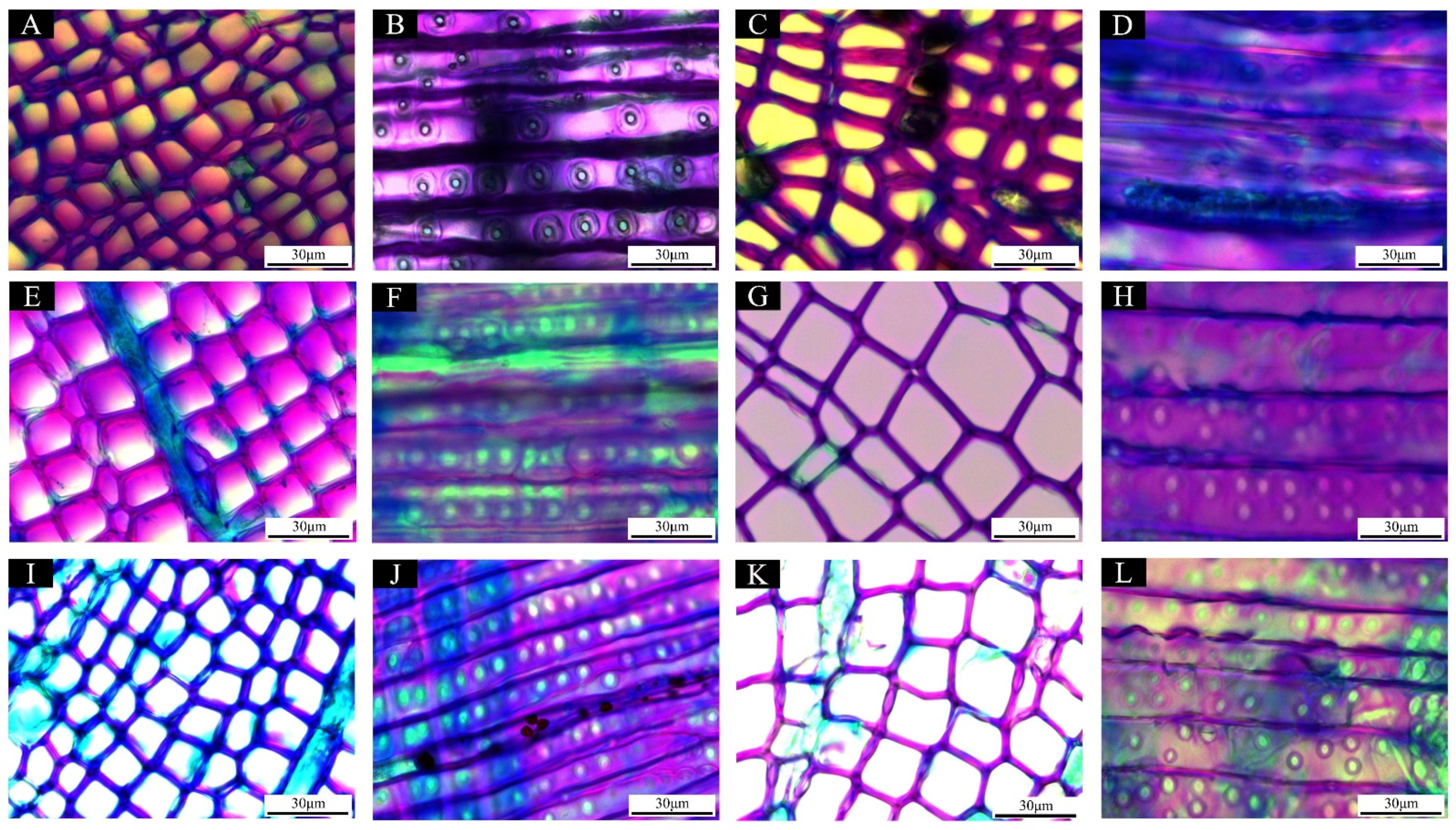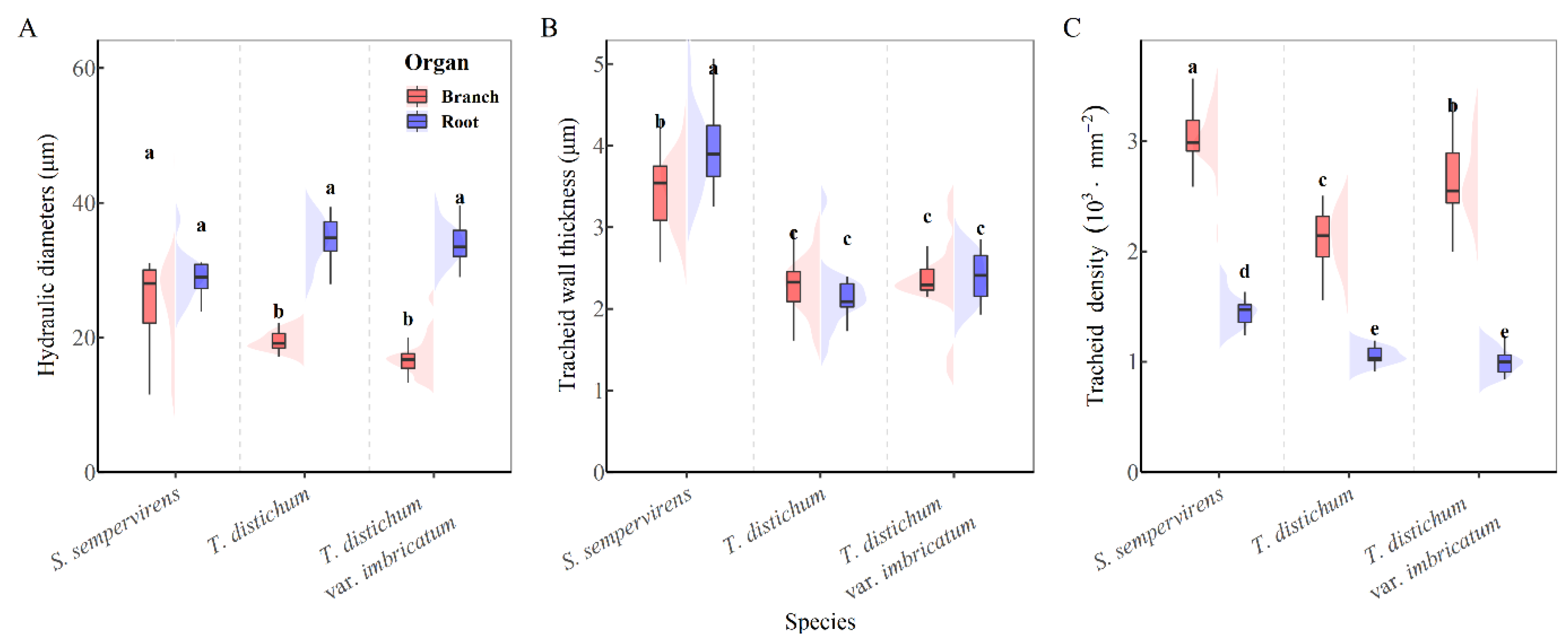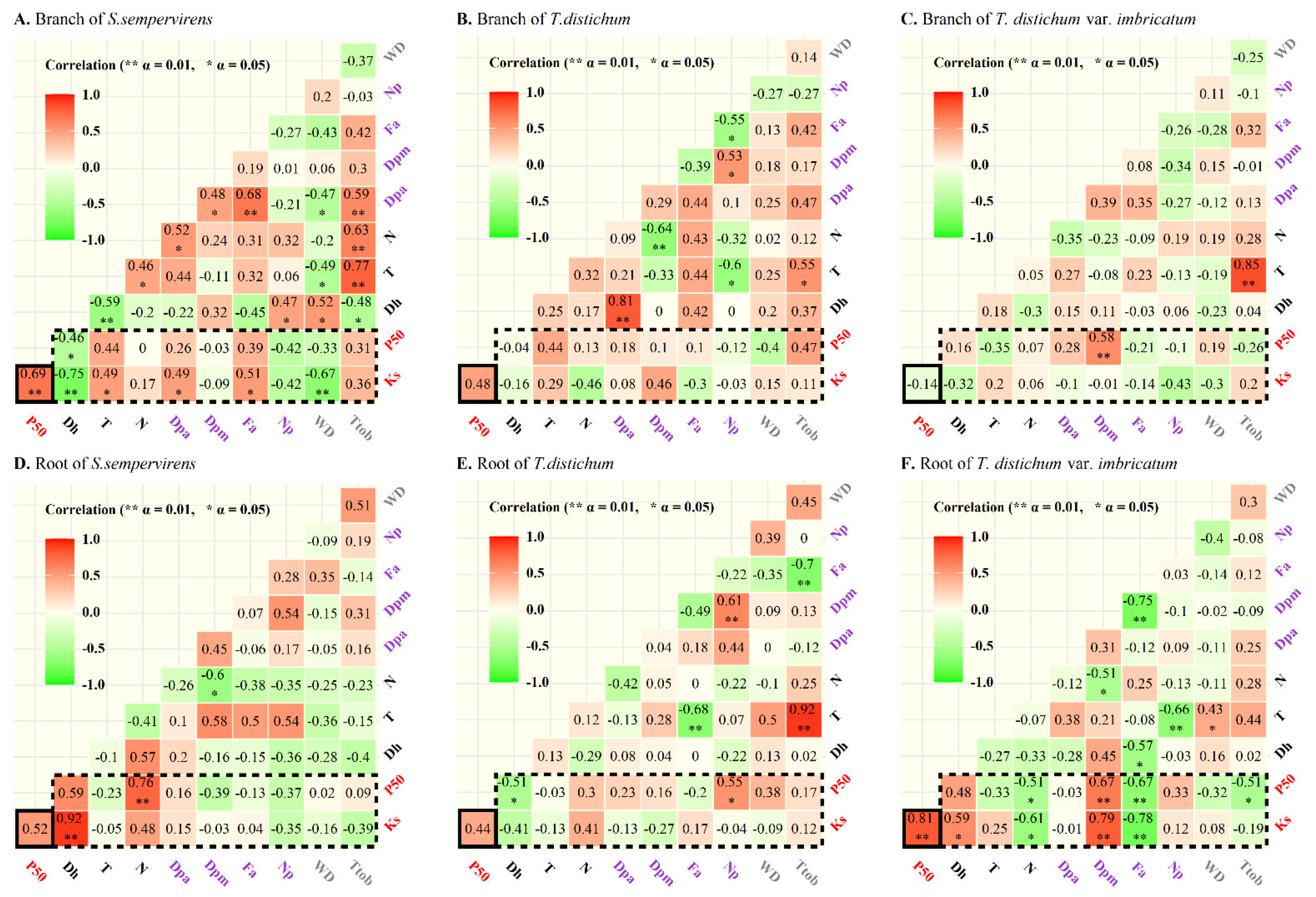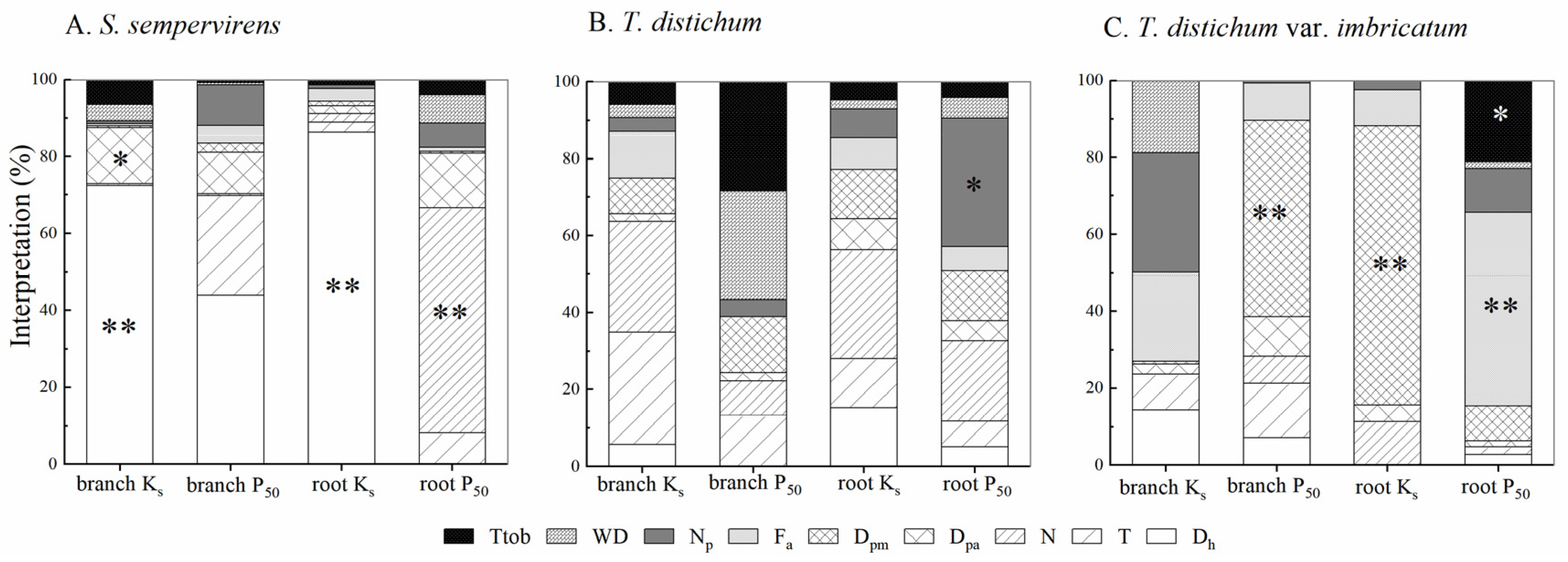Relationships between Xylem Transport, Anatomical, and Mechanical Traits at Organ Level of Two Cupressaceae Species
Abstract
1. Introduction
2. Materials and Methods
2.1. Site Description
2.2. Material Description
2.3. Hydraulic Conductivity and Cavitation Resistance in Branch/Root Xylem
2.4. The Anatomical Structure of Xylem
2.5. Mechanical Support
2.6. Statistical Analysis
3. Results
3.1. Hydraulic Functional Traits
3.2. Xylem Anatomical Structure
3.3. Quantitative Relationship between Functional Traits and Xylem Anatomical Structure
4. Discussion
4.1. Differences between Branch and Root Hydraulic Functional Traits
4.2. Efficiency–Safety Trade-Off
5. Conclusions
Supplementary Materials
Author Contributions
Funding
Data Availability Statement
Conflicts of Interest
References
- Huntington, T.G. Evidence for intensification of the global water cycle: Review and synthesis. J. Hydrol. 2006, 319, 83–95. [Google Scholar] [CrossRef]
- Li, D.; Si, J.; Zhang, X.; Gao, Y.; Gao, G. The Mechanism of Changes in Hydraulic Properties of Populus euphratica in Response to Drought Stress. Forests 2019, 10, 904. [Google Scholar] [CrossRef]
- Castillo-Argaez, R.; Vazquez, A.; Konkol, J.L.; Vargas, A.I.; Ploetz, R.C.; Etxeberria, E.; Schaffer, B. Sap flow, xylem anatomy and photosynthetic variables of three Persea species in response to laurel wilt. Tree Physiol. 2020, 41, 1004–1018. [Google Scholar] [CrossRef]
- Gleason, S.M.; Butler, D.W.; Ziemińska, K.; Waryszak, P.; Westoby, M. Stem xylem conductivity is key to plant water balance across Australian angiosperm species. Funct. Ecol. 2012, 26, 343–352. [Google Scholar] [CrossRef]
- Jiang, P.; Meinzer, F.C.; Fu, X.; Kou, L.; Dai, X.; Wang, H. Trade-offs between xylem water and carbohydrate storage among 24 coexisting subtropical understory shrub species spanning a spectrum of isohydry. Tree Physiol. 2020, 41, 403–415. [Google Scholar] [CrossRef]
- Skelton, R.; Diaz, J. Quantifying losses of plant hydraulic function: Seeing the forest, the trees and the xylem. Tree Physiol. 2020, 40, 285–289. [Google Scholar] [CrossRef]
- Wang, Y.; Li, Z.; Wang, Z.; Gu, J. Functional trait plasticity but not coordination differs in absorptive and transport fine roots in response to soil depth. Forests 2019, 11, 42. [Google Scholar] [CrossRef]
- Yang, J.; Michaud, J.; Jansen, S.; Schenk, H.J.; Zuo, Y.Y. Dynamic surface tension of xylem sap lipids. Tree Physiol. 2020, 40, 433–444. [Google Scholar] [CrossRef]
- Zhang, Y.; Lamarque, L.J.; Torres-Ruiz, J.M.; Schuldt, B.; Karimi, Z.; Li, S.; Qin, D.W.; Bittencourt, P.; Burlett, R.; Cao, K.F.; et al. Testing the plant pneumatic method to estimate xylem embolism resistance in stems of temperate trees. Tree Physiol. 2018, 38, 1016–1025. [Google Scholar] [CrossRef]
- Choat, B.; Jansen, S.; Brodribb, T.J.; Cochard, H. Global convergence in the vulnerability of forests to drought. Nature 2012, 491, 752–756. [Google Scholar] [CrossRef]
- Wright, I.; Reich, P.; Cornelissen, J.; Falster, D.; Garnier, E.; Hikosaka, K.; Lamont, B.; Lee, W.; Oleksyn, J.; Osada, N.; et al. Assessing the generality of global leaf trait relationships. New Phytol. 2005, 166, 485–496. [Google Scholar] [CrossRef]
- Wright, I.J.; Reich, P.B.; Westoby, M.; Ackerly, D.D.; Baruch, Z.; Bongers, F.; Cavender-Bares, J.; Chapin, T.; Cornelissen, J.H.C.; Diemer, M. The worldwide leaf economics spectrum. Nature 2004, 428, 821–827. [Google Scholar] [CrossRef]
- Fang, J.; Ye, L.; Chen, S.; Lu, S.; Pan, T.; Xie, J.; Li, Y.; Wang, Z. Differences in anatomical structure and hydraulic function of xylem in branches of angiosperms in field and garden habitats. Chin. J. Plant Ecol. 2021, 45, 650–658. [Google Scholar] [CrossRef]
- Han, X.; Zhao, M.; Wang, Z.; Ye, L.; Lu, S.; Chen, S.; Li, Y.; Xie, J. Adaptation of xylem structure and function of three gymnosperms to different habitats. Chin. J. Plant Ecol. 2022, 46, 440–450. [Google Scholar] [CrossRef]
- Dario, M.B.; Kevin, A.; Michael, E.; Miren, R.; Hans, B.; Isabel, C.E. Effects of drought on xylem anatomy and water-use efficiency of two co-occurring Pine species. Forests 2017, 8, 332. [Google Scholar]
- Wang, Z.Y.; Ding, X.R.; Li, Y.; Xie, J.B. The compensation effect between safety and efficiency in xylem and role in photosynthesis of gymnosperms. Physiol. Plant. 2022, 174, e13617. [Google Scholar] [CrossRef]
- Jordan, G.J.; Brodribb, T.J.; Blackman, C.J.; Weston, P.H. Climate drives vein anatomy in Proteaceae. Am. J. Bot. 2013, 100, 1483–1493. [Google Scholar] [CrossRef]
- Chen, J.W.; Zhang, Q.; Cao, L.K.F. Independence of stem and leaf hydraulic traits in six Euphorbiaceae tree species with contrasting leaf phenology. Planta 2009, 230, 459–468. [Google Scholar] [CrossRef]
- Lens, F.; Sperry, J.S.; Christman, M.A.; Choat, B.; Rabaey, D.; Jansen, S. Testing hypotheses that link wood anatomy to cavitation resistance and hydraulic conductivity in the genus Acer. New Phytol. 2011, 190, 709–723. [Google Scholar] [CrossRef]
- Pratt, R.B.; Jacobsen, A.L. Conflicting demands on angiosperm xylem: Tradeoffs among storage, transport and biomechanics. Plant Cell. Environ. 2017, 40, 897–913. [Google Scholar] [CrossRef]
- Holste, E.K.; Jerke, M.J.; Matzner, S.L. Long-term acclimatization of hydraulic properties, xylem conduit size, wall strength and cavitation resistance in Phaseolus vulgaris in response to different environmental effects. Plant Cell. Environ. 2006, 29, 836–843. [Google Scholar] [CrossRef]
- Mcculloh, K.A.; Sperry, J.S. Patterns in hydraulic architecture and their implications for transport efficiency. Tree Physiol. 2005, 25, 257–267. [Google Scholar] [CrossRef]
- Hacke, U.; Sperry, J.S.; Pockman, W.T.; Davis, S.D.; Mcculloh, K.A. Trends in wood density and structure are linked to prevention of xylem implosion by negative pressure. Oecologia 2001, 126, 457–461. [Google Scholar] [CrossRef]
- Chave, J.; Coomes, D.; Jansen, S.; Lewis, S.L.; Zanne, A.E. Towards a worldwide wood economics spectrum. Ecol. Lett. 2009, 12, 351–366. [Google Scholar] [CrossRef]
- Jacobsen, A.L.; Ewers, F.W.; Pratt, R.B.; Paddock, W.A.I.; Davis, S.D. Do xylem fibers affect vessel cavitation resistance? Plant Physiol. 2005, 139, 546–556. [Google Scholar] [CrossRef]
- Onoda, Y.; Richards, A.E.; Westoby, M. The relationship between stem biomechanics and wood density is modified by rainfall in 32 Australian woody plant species. New Phytol. 2009, 185, 493–501. [Google Scholar] [CrossRef]
- Gleason, S.M.; Westoby, M.; Jansen, S. Weak tradeoff between xylem safety and xylem-specific hydraulic efficiency across the world’s woody plant species. New Phytol. 2016, 209, 123–136. [Google Scholar] [CrossRef]
- Zimmermann, M.H. Xylem Structure and the Ascent of Sap. In Springer Series in Wood Science; Springer: Berlin, Germany, 1983. [Google Scholar]
- Johnson, D.M.; Mcculloh, K.A.; Meinzer, F.C.; Woodruff, D.R.; Eissenstat, D.M. Hydraulic patterns and safety margins, from stem to stomata, in three eastern US tree species. Tree Physiol. 2011, 31, 659–668. [Google Scholar] [CrossRef]
- Pivovaroff, A.L.; Sack, L.; Santiago, L.S. Coordination of stem and leaf hydraulic conductance in southern California shrubs: A test of the hydraulic segmentation hypothesis. New Phytol. 2014, 203, 842–850. [Google Scholar] [CrossRef]
- Bouche, P.S.; Delzon, S.; Choat, B.; Badel, E.; Brodribb, T.J.; Burlett, R.; Cochard, H.; Charra-Vaskou, K.; Lavigne, B.; Li, S. Are needles of Pinus pinaster more vulnerable to xylem embolism than branches? New insights from X-ray computed tomography. Plant Cell. Environ. 2016, 39, 860–870. [Google Scholar] [CrossRef]
- Elcan, J.M.; Pezeshki, S.R. Effects of Flooding on Susceptibility of Taxodium distichum L. Seedlings to Drought. Photosynthetica 2002, 40, 177–182. [Google Scholar] [CrossRef]
- Krauss, K.; Chambers, J.; Allen, J.; Luse, B.; DeBosier, A. Root and shoot responses of Taxodium distichum seedlings subjected to saline flooding. Environ. Exp. Bot. 1999, 41, v15–v23. [Google Scholar] [CrossRef]
- Burgess, S.S.; Pittermann, J.; Dawson, T.E. Hydraulic efficiency and safety of branch xylem increases with height in Sequoia sempervirens (D. Don) crowns. Plant Cell Environ. 2006, 29, 229–239. [Google Scholar] [CrossRef] [PubMed]
- Xie, J.B.; Wang, Z.Y.; Li, Y. Stomatal opening ratio mediates trait coordinating network adaptation to environmental gradients. New Phytol. 2022, 235, 907–922. [Google Scholar] [CrossRef]
- Sperry, J.S.; Saliendra, N.Z. Intra- and inter-plant variation in xylem cavitation in Betula occidentalis. Plant Cell. Environ. 1994, 17, 1233–1241. [Google Scholar] [CrossRef]
- Pratt, R.B.; Jacobsen, A.; Golgotiu, K.; Sperry, J.; Ewers, F.; Davis, S. Life history type and water stress tolerance in nine California chaparral species (Rhamnaceae). Ecol. Monogr. 2007, 77, 239–253. [Google Scholar] [CrossRef]
- Ennajeh, M.; Simões, F.; Khemira, H.; Cochard, H. How reliable is the double-ended pressure sleeve technique for assessing xylem vulnerability to cavitation in woody angiosperms? Physiol. Plant 2011, 142, 205–210. [Google Scholar] [CrossRef]
- Duursma, R.; Choat, B. fitplc-an R package to fit hydraulic vulnerability curves. J. Plant Hydra. 2017, 4, e002. [Google Scholar] [CrossRef]
- Ogle, K.; Barber, J.J.; Willson, C.; Thompson, B. Hierarchical statistical modeling of xylem vulnerability to cavitation. New Phytol. 2009, 182, 541–554. [Google Scholar] [CrossRef]
- Rosas, T.; Mencuccini, M.; Barba, J.; Cochard, H.; Saura-Mas, S.; Martínez-Vilalta, J. Adjustments and coordination of hydraulic, leaf and stem traits along a water availability gradient. New Phytol. 2019, 223, 632–646. [Google Scholar] [CrossRef]
- Liu, J.L.; Li, F.R.; Liu, C.A.; Liu, Q.J. Influences of shrub vegetation on distribution and diversity of a ground beetle community in a Gobi desert ecosystem. Biodivers. Conserv. 2012, 21, 2601–2619. [Google Scholar] [CrossRef]
- R Core Team. R: A Language and Environment for Statistical Computing; R Foundation for Statistical Computing: Vienna, Austria, 2021; Available online: https://www.R-project.org/ (accessed on 24 December 2019).
- Li, D.; Si, J.; Zhang, X.; Gao, Y.; Gao, G. Hydraulic characteristics of Populus euphratica in an arid environment. Forests 2019, 10, 407. [Google Scholar] [CrossRef]
- Philip, J.R. Plant water relations: Some physical aspects. Annu. Rev. Plant Physiol. Plant Mol. Biol. 1966, 17, 245–268. [Google Scholar] [CrossRef]
- Kavanagh, K.L.; Bond, B.J.; Aitken, S.N.; Gartner, B.L.; Knowe, S. Shoot and root vulnerability to xylem cavitation in four populations of Douglas-fir seedlings. Tree Physiol. 1999, 19, 31–37. [Google Scholar] [CrossRef] [PubMed]
- Sperry, J.S.; Takefumi, I. Xylem cavitation in roots and stems of Douglas-fir and white fir. Tree Physiol. 1997, 17, 275–280. [Google Scholar] [CrossRef] [PubMed]
- Guiqing, X.; Mcdowell, N.G.; Yan, L. A possible link between life and death of a xeric tree in desert. J. Plant Physiol. 2016, 194, 35–44. [Google Scholar]
- Hao, X.; Yan, L. Water-use strategy of three central Asian desert shrubs and their responses to rain pulse events. Plant. Soil 2006, 285, 5–17. [Google Scholar]
- Rodriguez-Dominguez, C.M.; Carins, M.R.; Christopher, L.; Brodribb, T.J. Mapping xylem failure in disparate organs of whole plants reveals extreme resistance in olive roots. New Phytol. 2018, 218, 1025–1035. [Google Scholar] [CrossRef]
- Corcuera, L.; Cochard, H.; Gil-Pelegrin, E.; Notivol, E. Phenotypic plasticity in mesic populations of Pinus pinaster improves resistance to xylem embolism (P50) under severe drought. Trees 2011, 25, 1033–1042. [Google Scholar] [CrossRef]
- Liu, Y.Y.; Wang, A.Y.; An, Y.N.; Lian, P.Y.; Wu, D.D.; Zhu, J.J.; Meinzer, F.C.; Hao, G.Y. Hydraulics play an important role in causing low growth rate and dieback of aging Pinus sylvestris var. mongolica trees in plantations of Northeast China. Plant Cell. Environ. 2018, 41, 1500–1511. [Google Scholar]
- Brodersen, C.R.; Roddy, A.B.; Wason, J.W.; McElrone, A.J. Functional status of xylem through time. Annu. Rev. Plant Biol. 2019, 70, 407–433. [Google Scholar] [CrossRef]
- Cochard, H.; Badel, E.; Herbette, S.; Delzon, S.; Choat, B.; Jansen, S. Methods for measuring plant vulnerability to cavitation: A critical review. J. Exp. Bot. 2013, 64, 4779–4791. [Google Scholar] [CrossRef]
- Reich, P.B. The world-wide ‘fast–slow’plant economics spectrum: A traits manifesto. J. Ecol. 2014, 102, 275–301. [Google Scholar] [CrossRef]
- Sperry, J.S. Evolution of water transport and xylem structure. Int. J. Plant Sci. 2003, 164, 115–127. [Google Scholar] [CrossRef]







| Taxa | Age | Height (m) | DBH (cm) | Canopy (m) | Agrotype | pH | Elevation (m) | Slope (°) |
|---|---|---|---|---|---|---|---|---|
| S. sempervirens | 20.79 ± 0.64 | 17.21 ± 0.46 | 18.14 ± 0.31 | 2.70 ± 0.09 | Red soil | 5.45 ± 0.13 | 40.43 ± 0.14 | 0.62 ± 0.07 |
| T. distichum | 16.89 ± 0.31 | 23.26 ± 0.48 | 16.73 ± 0.47 | 2.45 ± 0.09 | Red soil | 5.25 ± 0.10 | 40.42 ± 0.12 | 0.48 ± 0.03 |
| T. distichum var. imbricatum | 17.28 ± 0.54 | 23.78 ± 0.34 | 17.44 ± 0.46 | 2.61 ± 0.09 | Red soil | 5.35 ± 0.12 | 42.33 ± 0.51 | 1.83 ± 0.06 |
| Taxa | Organ | Ks (kg·s−1·m−1·Mpa−1) | P50 (-Mpa) | Dh (μm) | T (μm) | N (103·mm−2) | Dpa (μm) | Dpm (μm) | Fa | Np (103·mm−2) | WD (g·cm−3) |
|---|---|---|---|---|---|---|---|---|---|---|---|
| S. sempervirens | Branch | 0.52 ± 0.04 | 6.97 ± 0.77 | 28.60 ± 3.56 | 3.44 ± 0.10 | 3006.42 ± 73.38 | 3.92 ± 0.11 | 10.69 ± 0.24 | 0.37 ± 0.01 | 3149.25 ± 102.71 | 0.39 ± 0.01 |
| Root | 8.25 ± 0.19 | 0.60 ± 0.02 | 29.23 ± 1.09 | 3.95 ± 0.16 | 1462.34 ± 46.20 | 3.77 ± 0.11 | 12.69 ± 0.40 | 0.11 ± 0.00 | 2583.25 ± 50.64 | 0.38 ± 0.01 | |
| T. distichum | Branch | 0.78 ± 0.02 | 1.73 ± 0.16 | 19.51 ± 0.39 | 2.28 ± 0.09 | 2114.44 ± 71.54 | 4.04 ± 0.14 | 9.96 ± 0.26 | 0.40 ± 0.01 | 3512.81 ± 139.01 | 0.36 ± 0.01 |
| Root | 1.19 ± 0.11 | 1.14 ± 0.09 | 34.50 ± 0.88 | 2.16 ± 0.11 | 1056.49 ± 21.56 | 4.15 ± 0.09 | 10.39 ± 0.31 | 0.16 ± 0.00 | 3436.32 ± 103.60 | 0.32 ± 0.01 | |
| T. distichum var. imbricatum | Branch | 1.23 ± 0.06 | 1.66 ± 0.17 | 17.15 ± 0.68 | 2.34 ± 0.11 | 2648.80 ± 80.72 | 3.82 ± 0.11 | 9.71 ± 0.22 | 0.39 ± 0.01 | 4479.59 ± 151.75 | 0.41 ± 0.01 |
| Root | 1.36 ± 0.13 | 0.59 ± 0.07 | 33.80 ± 0.70 | 2.38 ± 0.08 | 1000.62 ± 30.12 | 4.32 ± 0.14 | 11.02 ± 0.28 | 0.17 ± 0.01 | 3373.53 ± 73.85 | 0.25 ± 0.01 |
Publisher’s Note: MDPI stays neutral with regard to jurisdictional claims in published maps and institutional affiliations. |
© 2022 by the authors. Licensee MDPI, Basel, Switzerland. This article is an open access article distributed under the terms and conditions of the Creative Commons Attribution (CC BY) license (https://creativecommons.org/licenses/by/4.0/).
Share and Cite
Xie, J.-B.; Zhang, B.-N.; Wang, Z.-Y. Relationships between Xylem Transport, Anatomical, and Mechanical Traits at Organ Level of Two Cupressaceae Species. Forests 2022, 13, 1564. https://doi.org/10.3390/f13101564
Xie J-B, Zhang B-N, Wang Z-Y. Relationships between Xylem Transport, Anatomical, and Mechanical Traits at Organ Level of Two Cupressaceae Species. Forests. 2022; 13(10):1564. https://doi.org/10.3390/f13101564
Chicago/Turabian StyleXie, Jiang-Bo, Bo-Na Zhang, and Zhong-Yuan Wang. 2022. "Relationships between Xylem Transport, Anatomical, and Mechanical Traits at Organ Level of Two Cupressaceae Species" Forests 13, no. 10: 1564. https://doi.org/10.3390/f13101564
APA StyleXie, J.-B., Zhang, B.-N., & Wang, Z.-Y. (2022). Relationships between Xylem Transport, Anatomical, and Mechanical Traits at Organ Level of Two Cupressaceae Species. Forests, 13(10), 1564. https://doi.org/10.3390/f13101564




